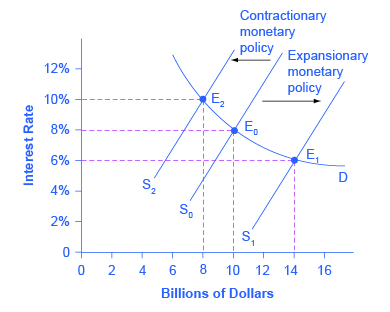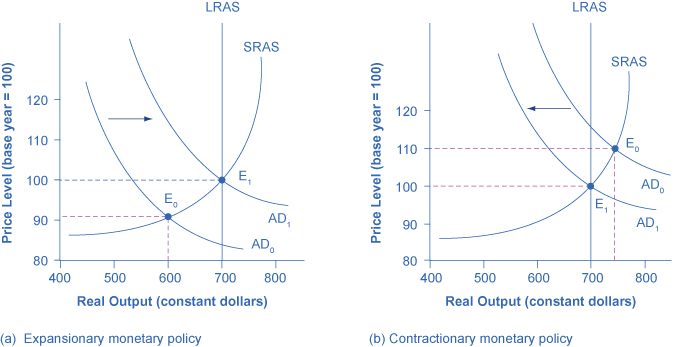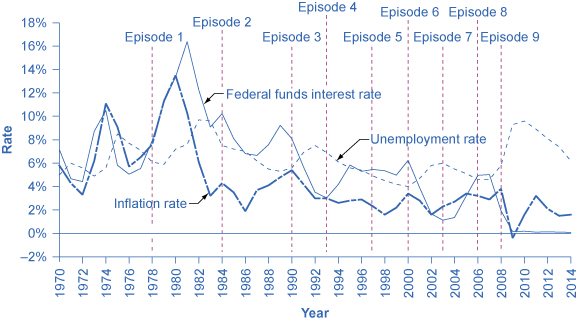Macroeconomic Models for Monetary Policy a Critical Review From a Finance Perspective
Chapter 28. Monetary Policy and Bank Regulation
28.4 Monetary Policy and Economic Outcomes
Learning Objectives
By the end of this section, yous will be able to:
- Contrast expansionary monetary policy and contractionary monetary policy
- Explain how monetary policy impacts interest rates and aggregate demand
- Evaluate Federal Reserve decisions over the last forty years
- Explain the significance of quantitative easing (QE)
A monetary policy that lowers involvement rates and stimulates borrowing is known as an expansionary monetary policy or loose budgetary policy. Conversely, a monetary policy that raises interest rates and reduces borrowing in the economic system is a contractionary monetary policy or tight monetary policy. This module will discuss how expansionary and contractionary monetary policies affect involvement rates and amass demand, and how such policies will affect macroeconomic goals similar unemployment and inflation. We will conclude with a look at the Fed's monetary policy practise in contempo decades.
The Issue of Monetary Policy on Interest Rates
Consider the market for loanable banking company funds, shown in Effigy 1. The original equilibrium (E0) occurs at an involvement rate of 8% and a quantity of funds loaned and borrowed of $10 billion. An expansionary monetary policy will shift the supply of loanable funds to the right from the original supply curve (S0) to S1, leading to an equilibrium (East1) with a lower interest rate of vi% and a quantity of funds loaned of $14 billion. Conversely, a contractionary monetary policy will shift the supply of loanable funds to the left from the original supply curve (S0) to Stwo, leading to an equilibrium (Eii) with a higher interest charge per unit of x% and a quantity of funds loaned of $eight billion.

So how does a central banking company "enhance" interest rates? When describing the monetary policy actions taken by a central bank, it is mutual to hear that the central depository financial institution "raised interest rates" or "lowered interest rates." Nosotros demand to be articulate about this: more than precisely, through open marketplace operations the central bank changes bank reserves in a way which affects the supply curve of loanable funds. Equally a issue, interest rates modify, every bit shown in Effigy one. If they exercise not meet the Fed'due south target, the Fed can supply more or less reserves until involvement rates practice.
Call back that the specific interest rate the Fed targets is the federal funds rate. The Federal Reserve has, since 1995, established its target federal funds charge per unit in advance of whatsoever open up market operations.
Of course, financial markets display a broad range of interest rates, representing borrowers with different risk premiums and loans that are to be repaid over different periods of time. In full general, when the federal funds rate drops substantially, other interest rates drop, too, and when the federal funds rate rises, other interest rates ascension. Nonetheless, a autumn or ascension of one percentage indicate in the federal funds rate—which call back is for borrowing overnight—will typically have an effect of less than one percentage signal on a thirty-yr loan to buy a house or a three-year loan to purchase a automobile. Monetary policy tin can push the entire spectrum of interest rates college or lower, just the specific interest rates are set by the forces of supply and need in those specific markets for lending and borrowing.
The Result of Monetary Policy on Aggregate Demand
Monetary policy affects interest rates and the available quantity of loanable funds, which in turn affects several components of amass demand. Tight or contractionary monetary policy that leads to higher involvement rates and a reduced quantity of loanable funds volition reduce ii components of aggregate need. Business investment will refuse because it is less attractive for firms to borrow money, and fifty-fifty firms that have money will notice that, with higher interest rates, information technology is relatively more than attractive to put those funds in a financial investment than to make an investment in concrete capital. In add-on, higher interest rates volition discourage consumer borrowing for large-ticket items similar houses and cars. Conversely, loose or expansionary monetary policy that leads to lower involvement rates and a college quantity of loanable funds will tend to increment business organisation investment and consumer borrowing for large-ticket items.
If the economy is suffering a recession and loftier unemployment, with output beneath potential Gross domestic product, expansionary monetary policy can help the economy return to potential GDP. Effigy two (a) illustrates this situation. This instance uses a short-run upward-sloping Keynesian aggregate supply curve (SRAS). The original equilibrium during a recession of Eastward0 occurs at an output level of 600. An expansionary monetary policy volition reduce interest rates and stimulate investment and consumption spending, causing the original amass need curve (AD0) to shift right to Ad1, and so that the new equilibrium (East1) occurs at the potential GDP level of 700.

Conversely, if an economy is producing at a quantity of output to a higher place its potential Gdp, a contractionary monetary policy can reduce the inflationary pressures for a rise price level. In Effigy ii (b), the original equilibrium (E0) occurs at an output of 750, which is above potential GDP. A contractionary monetary policy volition raise involvement rates, discourage borrowing for investment and consumption spending, and crusade the original demand curve (Advertizing0) to shift left to Advertizing1, so that the new equilibrium (Eastane) occurs at the potential GDP level of 700.
These examples suggest that monetary policy should exist countercyclical; that is, information technology should act to counterbalance the business cycles of economic downturns and upswings. Monetary policy should be loosened when a recession has caused unemployment to increase and tightened when inflation threatens. Of course, countercyclical policy does pose a danger of overreaction. If loose monetary policy seeking to end a recession goes too far, it may push button aggregate demand then far to the right that it triggers inflation. If tight monetary policy seeking to reduce inflation goes likewise far, information technology may push button amass demand and then far to the left that a recession begins. Figure 3 (a) summarizes the chain of effects that connect loose and tight monetary policy to changes in output and the price level.

Federal Reserve Deportment Over Last Four Decades
For the period from the mid-1970s up through the terminate of 2007, Federal Reserve budgetary policy can largely be summed up by looking at how it targeted the federal funds involvement rate using open market operations.
Of class, telling the story of the U.S. economy since 1975 in terms of Federal Reserve deportment leaves out many other macroeconomic factors that were influencing unemployment, recession, economic growth, and inflation over this time. The ix episodes of Federal Reserve action outlined in the sections below also demonstrate that the central bank should exist considered one of the leading actors influencing the macro economy. As noted earlier, the single person with the greatest power to influence the U.S. economic system is probably the chairperson of the Federal Reserve.
Effigy four shows how the Federal Reserve has carried out budgetary policy by targeting the federal funds interest charge per unit in the last few decades. The graph shows the federal funds interest rate (remember, this involvement charge per unit is gear up through open market operations), the unemployment charge per unit, and the inflation rate since 1975. Dissimilar episodes of monetary policy during this menses are indicated in the figure.

Episode 1
Consider Episode i in the late 1970s. The rate of inflation was very high, exceeding x% in 1979 and 1980, so the Federal Reserve used tight monetary policy to heighten interest rates, with the federal funds rate rising from five.5% in 1977 to 16.iv% in 1981. By 1983, inflation was down to 3.ii%, but amass demand contracted sharply enough that back-to-back recessions occurred in 1980 and in 1981–1982, and the unemployment rate rose from 5.8% in 1979 to 9.7% in 1982.
Episode two
In Episode 2, when the Federal Reserve was persuaded in the early 1980s that inflation was declining, the Fed began slashing involvement rates to reduce unemployment. The federal funds involvement charge per unit fell from 16.4% in 1981 to 6.eight% in 1986. By 1986 or so, inflation had fallen to about ii% and the unemployment rate had come down to 7%, and was withal falling.
Episode 3
However, in Episode 3 in the late 1980s, aggrandizement appeared to exist creeping upwardly again, rising from ii% in 1986 up toward five% by 1989. In response, the Federal Reserve used contractionary monetary policy to raise the federal funds rates from vi.6% in 1987 to 9.two% in 1989. The tighter monetary policy stopped inflation, which vicious from above 5% in 1990 to under three% in 1992, but it besides helped to crusade the recession of 1990–1991, and the unemployment rate rose from 5.iii% in 1989 to vii.5% by 1992.
Episode 4
In Episode 4, in the early 1990s, when the Federal Reserve was confident that inflation was back under command, information technology reduced involvement rates, with the federal funds interest rate falling from 8.ane% in 1990 to 3.5% in 1992. As the economic system expanded, the unemployment rate declined from seven.5% in 1992 to less than 5% by 1997.
Episodes v and 6
In Episodes five and 6, the Federal Reserve perceived a risk of aggrandizement and raised the federal funds rate from iii% to 5.8% from 1993 to 1995. Aggrandizement did non rise, and the period of economic growth during the 1990s connected. So in 1999 and 2000, the Fed was concerned that inflation seemed to be creeping upwards so it raised the federal funds interest rate from 4.6% in December 1998 to 6.5% in June 2000. Past early on 2001, aggrandizement was declining again, only a recession occurred in 2001. Betwixt 2000 and 2002, the unemployment rate rose from 4.0% to 5.viii%.
Episodes vii and 8
In Episodes 7 and 8, the Federal Reserve conducted a loose monetary policy and slashed the federal funds rate from 6.2% in 2000 to but 1.7% in 2002, and then over again to one% in 2003. They actually did this because of fearfulness of Nippon-way deflation; this persuaded them to lower the Fed funds farther than they otherwise would take. The recession ended, but, unemployment rates were slow to decline in the early on 2000s. Finally, in 2004, the unemployment rate declined and the Federal Reserve began to raise the federal funds rate until it reached v% by 2007.
Episode 9
In Episode nine, as the Great Recession took concur in 2008, the Federal Reserve was quick to slash involvement rates, taking them downwardly to 2% in 2008 and to nearly 0% in 2009. When the Fed had taken interest rates down to well-nigh-zero by Dec 2008, the economy was withal deep in recession. Open up market operations could not make the involvement rate turn negative. The Federal Reserve had to remember "outside the box."
Quantitative Easing
The most powerful and usually used of the three traditional tools of monetary policy—open marketplace operations—works past expanding or contracting the coin supply in a manner that influences the involvement rate. In belatedly 2008, as the U.S. economic system struggled with recession, the Federal Reserve had already reduced the interest rate to near-zero. With the recession still ongoing, the Fed decided to adopt an innovative and nontraditional policy known as quantitative easing (QE). This is the buy of long-term government and private mortgage-backed securities by central banks to make credit available so equally to stimulate aggregate demand.
Quantitative easing differed from traditional budgetary policy in several cardinal means. Kickoff, it involved the Fed purchasing long term Treasury bonds, rather than short term Treasury bills. In 2008, yet, information technology was impossible to stimulate the economy whatsoever further by lowering short term rates because they were already equally low as they could get. (Read the closing Bring it Home feature for more than on this.) Therefore, Bernanke sought to lower long-term rates utilizing quantitative easing.
This leads to a second way QE is unlike from traditional monetary policy. Instead of purchasing Treasury securities, the Fed also began purchasing private mortgage-backed securities, something it had never done before. During the fiscal crisis, which precipitated the recession, mortgage-backed securities were termed "toxic assets," because when the housing market collapsed, no i knew what these securities were worth, which put the financial institutions which were belongings those securities on very shaky basis. By offering to purchase mortgage-backed securities, the Fed was both pushing long term interest rates downward and likewise removing possibly "toxic assets" from the remainder sheets of private financial firms, which would strengthen the financial organisation.
Quantitative easing (QE) occurred in 3 episodes:
- During QEi, which began in Nov 2008, the Fed purchased $600 billion in mortgage-backed securities from government enterprises Fannie Mae and Freddie Mac.
- In November 2010, the Fed began QEtwo, in which it purchased $600 billion in U.S. Treasury bonds.
- QEiii, began in September 2012 when the Fed commenced purchasing $40 billion of additional mortgage-backed securities per calendar month. This amount was increased in Dec 2012 to $85 billion per month. The Fed stated that, when economic conditions permit, it will begin tapering (or reducing the monthly purchases). By Oct 2014, the Fed had announced the final $15 billion purchase of bonds, catastrophe Quantitative Easing.
The quantitative easing policies adopted by the Federal Reserve (and by other central banks around the world) are usually thought of as temporary emergency measures. If these steps are, indeed, to be temporary, then the Federal Reserve will need to terminate making these additional loans and sell off the fiscal securities information technology has accumulated. The concern is that the process of quantitative easing may testify more hard to reverse than it was to enact. The testify suggests that QE1 was somewhat successful, but that QE2 and QEthree have been less and so.
Key Concepts and Summary
An expansionary (or loose) monetary policy raises the quantity of money and credit above what it otherwise would have been and reduces interest rates, boosting amass demand, and thus countering recession. A contractionary budgetary policy, besides called a tight monetary policy, reduces the quantity of money and credit beneath what it otherwise would accept been and raises interest rates, seeking to hold downwards inflation. During the 2008–2009 recession, central banks around the world also used quantitative easing to expand the supply of credit.
Self-Cheque Questions
- Why does contractionary monetary policy cause interest rates to rise?
- Why does expansionary monetary policy causes interest rates to drop?
Review Questions
- How practice the expansionary and contractionary monetary policy touch on the quantity of money?
- How do tight and loose budgetary policy bear upon involvement rates?
- How do expansionary, tight, contractionary, and loose monetary policy touch aggregate need?
- Which kind of monetary policy would yous expect in response to high aggrandizement: expansionary or contractionary? Why?
- Explain how to use quantitative easing to stimulate aggregate demand.
Critical Thinking Questions
A well-known economic model called the Phillips Curve (discussed in The Keynesian Perspective chapter) describes the short run tradeoff typically observed between inflation and unemployment. Based on the discussion of expansionary and contractionary budgetary policy, explicate why one of these variables usually falls when the other rises.
Glossary
- contractionary monetary policy
- a budgetary policy that reduces the supply of money and loans
- countercyclical
- moving in the contrary direction of the business concern cycle of economic downturns and upswings
- expansionary budgetary policy
- a budgetary policy that increases the supply of coin and the quantity of loans
- federal funds rate
- the interest charge per unit at which one bank lends funds to another depository financial institution overnight
- loose monetary policy
- come across expansionary monetary policy
- quantitative easing (QE)
- the purchase of long term government and private mortgage-backed securities past central banks to make credit bachelor in hopes of stimulating amass demand
- tight budgetary policy
- run across contractionary monetary policy
Solutions
Answers to Cocky-Check Questions
- Contractionary policy reduces the corporeality of loanable funds in the economic system. Equally with all goods, greater scarcity leads a greater cost, then the involvement rate, or the price of borrowing money, rises.
- An increase in the amount of available loanable funds means that in that location are more people who want to lend. They, therefore, bid the price of borrowing (the involvement charge per unit) downwardly.
cervantesponerver.blogspot.com
Source: https://opentextbc.ca/principlesofeconomics/chapter/28-4-monetary-policy-and-economic-outcomes/
0 Response to "Macroeconomic Models for Monetary Policy a Critical Review From a Finance Perspective"
Kommentar veröffentlichen